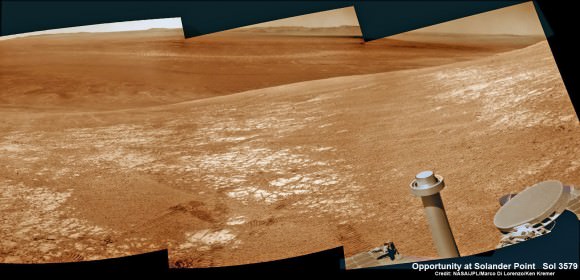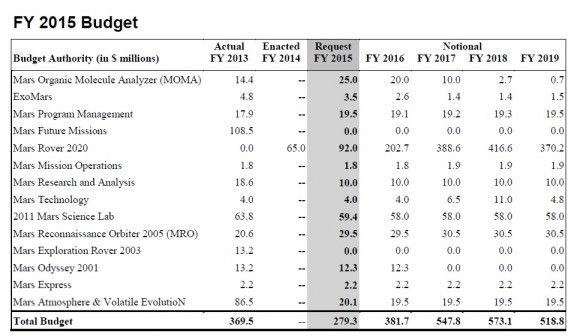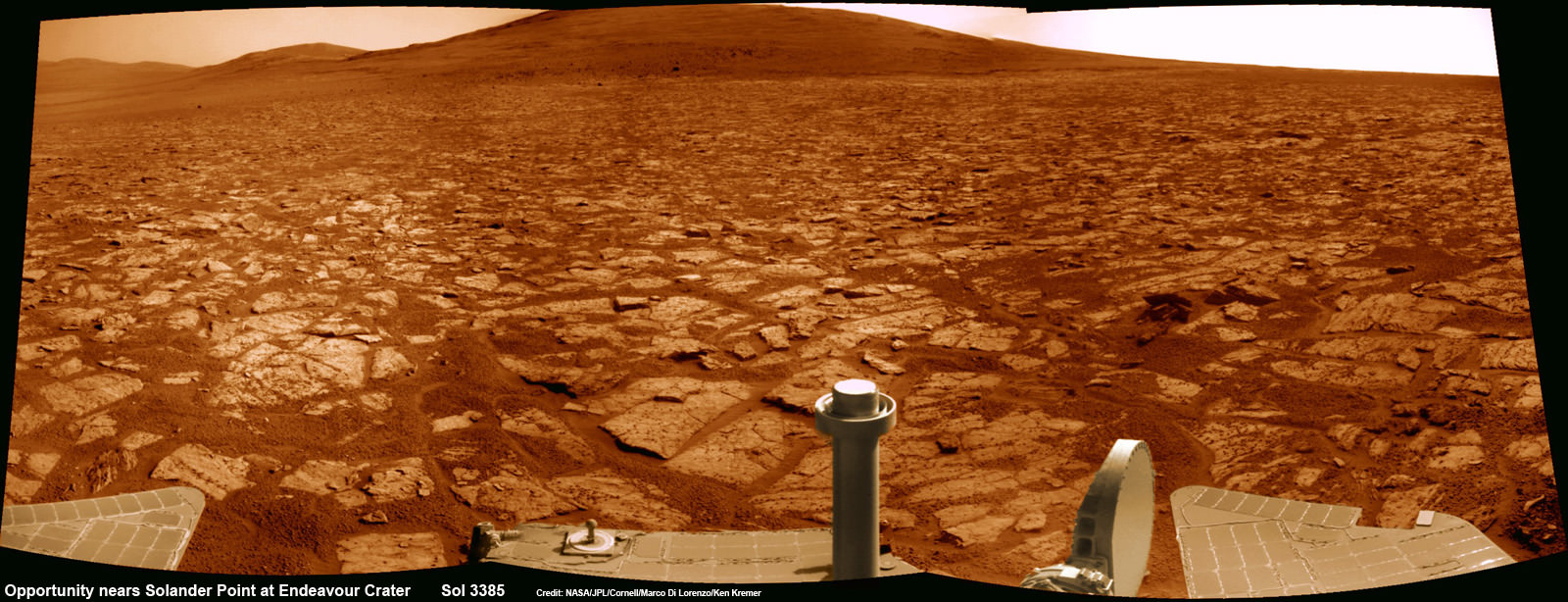NASA’s preliminary (read: not finalized) budget for 2015 would eliminate funding for the long-running Opportunity rover mission that’s discovered extensive evidence of past water on Mars in the past decade.
While the agency’s baseline budget request shows no funding for the long-running Mars mission past 2015, NASA added that Opportunity is among several missions that could receive extension money if extra funds become available. Also, the budget needs to be approved by Congress before anything is set in stone.
Here’s where Opportunity could get funding, under the current structure: The White House has proposed a $56 billion “Opportunity, Growth and Security Initiative” across the U.S. government that would surpass the budgetary spending limit that Congress set in December. (Some news reports indicate the Republicans are not on board with this, but it’s early yet.)

Within NASA, that translates into an extra $885.5 million that would be used for certain priority areas in science, aeronautics, space technology, exploration, space operations, education and other items. If the funding goes through and if it is approved in full, Opportunity could receive money within $35 million allocated in planetary science extended mission funding for 2015.
NASA, meanwhile, is undertaking a regular review of several Mars programs (among others) to see which ones give the best return for funding. “The missions to be reviewed include MSL [Mars Science Laboratory/Curiosity], MRO [Mars Reconnaissance Orbiter], Opportunity, Odyssey and Mars Express,” NASA stated. But as the table below shows, right now Opportunity has no funding in fiscal 2015, while the other missions do. (Note that funding would cease for Odyssey in 2017 under this plan.)

Here’s what NASA’s budget request says about the extended funding:
“Planetary Science Extended Mission Funding: Provide an additional $35.0 million to increase support for extended missions prioritized in the upcoming 2014 Senior Review. The Budget provides funding for high priority extended missions such as Cassini and Curiosity. However, it does not provide funding to continue all missions that are likely to be highly rated in Senior Review. The funding augmentation would allow robust funding for all extended missions that are highly ranked by the 2014 Senior Review, enabling high science return at relatively low cost, instead of potentially terminating up to two missions or reducing science across many or all of them.”
On Twitter, the Planetary Society’s Casey Dreier, its director of advocacy, wrote a few tweets about the budget last night, including one addressing Opportunity. “As expected, MER Opportunity has no funding as of Oct 1st, unless supplemental funding is added,” he said, adding that a bright spot is that the Curiosity mission has funding through fiscal 2019 (which is as far as the numbers go in the budget request.)

There’s far more context to this than can be provided in a single news story, so we encourage you to check out the 713-page NASA budget request as well as NASA’s full budget documentation.
Opportunity landed on Mars in January 2004 and has rolled more than 24 miles (38 kilometers) in the years since, long outliving its twin Spirit (who ceased communications in 2010). Universe Today’s Ken Kremer recently covered the contributions these rovers made to science in the past 10 years.
The last Opportunity update on March 4 described how controllers deliberately crushed a rock under the rover’s wheels as it explored Endeavor Crater, where Opportunity has been trundling along since 2011.
On an unrelated note, NASA announced today (March 11) that the Mars Reconnaissance Orbiter went into safe mode “after an unscheduled swap from one main computer to another”, but the spacecraft is expected to be working normally in a few days. (MRO has been through several safe mode incidents over the years, including several times in 2009.)


What actually costs so much money in continuing a mission like this? I’m not being facetious, I just really don’t know enough about what’s involved in maintaining something like Opportunity to understand why it costs several million dollars per year when there’s not much anyone can do to interact with the rover besides radio signals. Is it just the salaries of the technicians, or is there some cost sink I’m overlooking?
I believe they are still driving it around (or at least will be again after the Winter passes). I just peaked at the Wiki-P article to see if I missed some news about it not propelling any more and saw nothing. Did I drop the ball?
You’ve got to pay the scientists, you’ve got to pay the engineers, you’ve got to pay for all the high-tech infrastructure that allows you to communicate with the rover. From what I can tell, the operating budget is around $15 million a year, which sounds reasonable to me. (And a pittance in terms of the overall federal budget, or even NASA’s.)
We should stop funding all that “Earth Climate-science” crap and refund real space exploration.
So we should forget about understanding our own planet and focus on understanding other ones? Does that make any sense at all?
NASA is all about disappointment nowadays, isn’t it?!? What a disgusting shameful display of wastefulness: an amazingly successful rover – which is still in perfect working order after 10 YEARS (!!!), and now they just going to let it die because they don’t feel like funding it anymore. How can you abandon such a star performing probe, after spending billions of getting it there?!?
If they’re bored with it, I’ve got an idea: Why not drive it towards Mariner Valley, and have a look at one of the most spectacular sights in the solar system, instead of looking around boring craters?
I wish the Chinese Space program the best of luck… These stupid American bureaucrats needs to have some healthy competition in order for them to appreciate a good thing when they see it!
Someone else had tweeted this, and I like the idea of having a university science department continue on with this great mission. What an opportunity for college students.